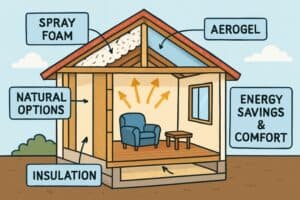Key Takeaways
- Modern insulation materials, such as spray foam and aerogel, offer superior thermal resistance, dramatically enhancing home energy performance.
- Natural alternatives such as sheep’s wool and hemp serve as eco-friendly, highly effective insulation options.
- Smart insulation systems leverage technology to enhance comfort and energy savings by responding to real-time temperature changes.
- Proper installation and regular maintenance are crucial to ensure insulation performs as intended and stands the test of time.
Creating a home that’s comfortable year-round while keeping utility bills manageable is more achievable than ever, thanks to advancements in insulation materials and technologies. Today’s homeowners can take advantage of a variety of solutions designed to meet every need—from cutting-edge materials offering high thermal resistance to smart technology that optimizes energy use. For homeowners seeking to surpass traditional options, innovative installations like comprehensive attic services can unlock even greater energy savings and enhanced home comfort.
Whether upgrading an existing home or building new, the right insulation strategy is key to keeping heat where you want it—and out where you don’t. By exploring high-performance and sustainable alternatives, you can ensure your home remains efficient, healthy, and cost-effective for years to come. Choosing the right solution and working with reputable providers of attic and whole-home services will further maximize insulation effectiveness and household value.
Spray Foam Insulation: Sealing the Gaps
Spray foam insulation stands out for its ability to create a seamless, airtight barrier wherever it’s applied. Unlike batt or loose-fill insulation, spray foam expands to fill even the smallest gaps and cracks, which are often the culprits behind energy loss in homes. This expansion ensures there’s no room for unwanted air infiltration, resulting in consistently comfortable indoor temperatures and noticeable reductions in heating and cooling costs. Additionally, spray foam significantly enhances soundproofing, contributing to a quieter, more tranquil living space. According to Energy.gov, homeowners often realize up to 20% in energy savings simply by sealing air leaks with modern insulation like spray foam.
Aerogel Insulation: The Space-Age Material
Aerogel, sometimes called “frozen smoke” due to its ethereal appearance, brings space technology into your living room. Originally designed for spacecraft, aerogel is one of the world’s best insulators, offering extremely high resistance to heat transfer despite being incredibly lightweight and thin. This makes it an excellent choice for projects where space is critical, such as retrofitting older homes with smaller wall cavities. While aerogel’s higher upfront cost might deter some, its long lifespan and substantial energy savings make it a smart long-term investment.
Natural Insulation Options: Sustainable and Effective
The demand for environmentally responsible building materials has driven growth in natural insulation products like sheep’s wool and hemp. These renewable materials offer many benefits: sheep’s wool, for example, can naturally manage moisture levels without losing its thermal properties, reducing risks of mold and dampness inside the home. Hemp insulation is fully biodegradable, low in toxins, and provides excellent sound absorption. Both options appeal to those interested in minimizing their environmental impact while maintaining a comfortable, well-insulated home.
Smart Insulation Systems: Integrating Technology
As homes become smarter, so do their insulation systems. Modern smart insulation can be integrated with temperature and humidity sensors that communicate with a central home automation system. These sensors continuously monitor building conditions, automatically adjusting insulation characteristics to optimize energy use. For example, smart insulation panels can adjust their structure to regulate airflow, maintaining optimal comfort while reducing heating and cooling costs. This connectivity empowers homeowners with actionable insights, enabling them to maintain optimal control over their indoor environments and further reduce their energy bills.
Reflective Insulation: Keeping Heat at Bay
Reflective or radiant barrier insulation is especially useful in homes exposed to strong sunlight or located in hot climates. It works not by absorbing heat, but by reflecting radiant energy away from living spaces, typically installed in attics, under floors, or on walls that are prone to overheating. By minimizing the amount of heat that enters the home, reflective insulation decreases the workload on air conditioning systems and helps maintain a cooler, more comfortable interior with less energy use.

Continuous Insulation: Eliminating Thermal Bridges
Thermal bridges—gaps or weak points in the insulation envelope—are common culprits for energy loss in buildings. Continuous insulation is a solution that ensures no part of the home is left unprotected, applying insulating material over the entire building envelope to eliminate those weak spots. By creating an uninterrupted layer covering all structural elements, continuous insulation dramatically reduces heat flow, increases overall efficiency, and guards against fluctuating indoor temperatures.
Proper Installation and Maintenance: Ensuring Optimal Performance
No insulation, regardless of how innovative, will achieve its full potential unless it’s properly installed. Gaps, compression, and incorrect placement can all reduce insulation’s effectiveness and undermine energy savings. Homeowners and professionals alike should prioritize thorough installation and schedule regular checks to identify wear, moisture intrusion, or other issues. Ongoing maintenance helps safeguard comfort and efficiency over the long term, and can be key to preserving warranty protections and maximizing investment.
Integrating these modern insulation approaches—from advanced materials to high-tech systems and seamless application techniques—creates comfortable, energy-efficient living environments that are ready for the future. Staying up to date on the latest insulation developments and trusting experienced local providers will keep your home’s energy costs under control, all while making it a more enjoyable place to live.


